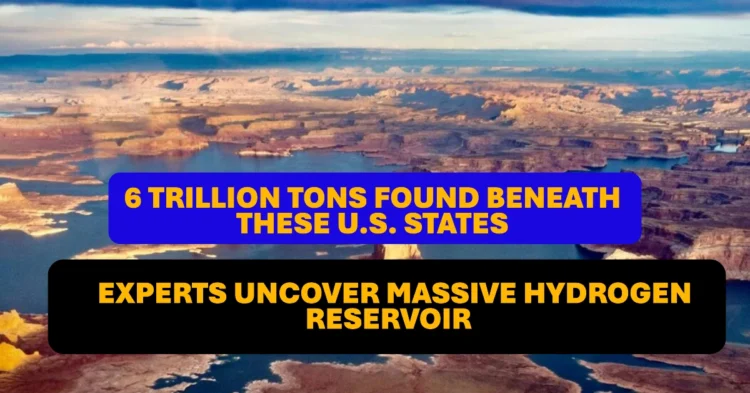The Future of Clean Energy Lies Beneath Our Feet
Hydrogen has long been hailed as a potential game-changer in the quest to reduce carbon emissions. While most of the world has focused on industrially-produced hydrogen, a groundbreaking discovery has revealed something extraordinary: the Earth holds a massive, naturally occurring hydrogen reservoir—estimated at more than six trillion metric tons. This revelation could fundamentally reshape how we approach clean energy, and several U.S. states are poised to lead this transformation.
Table of Contents
How the Earth Produces Its Own Hydrogen
Serpentinization: Nature’s High-Pressure Reaction
One of the primary ways Earth creates hydrogen is through serpentinization, a natural geochemical reaction. When rocks rich in iron and magnesium—commonly found in the Earth’s mantle—encounter water under intense heat and pressure, a reaction occurs. Electrons transfer from iron to water, resulting in the formation of molecular hydrogen, along with iron oxides and silica compounds.
Radioactive Breakdown of Elements
Another hydrogen-producing process is the radioactive degradation of elements such as uranium and thorium. This process also splits water molecules to release hydrogen, though it occurs at a much slower pace than serpentinization. Over time, this hydrogen accumulates in porous rock formations, often trapped beneath impermeable layers of shale or salt.
What the Science Says: A Vast Global and Domestic Resource
Researchers from the U.S. Geological Survey (USGS), led by Sarah E. Gelman and Geoffrey S. Ellis, have estimated that about 5.6 trillion metric tons of hydrogen are stored in geological formations across the globe. In addition, between 15 million and 31 million metric tons of hydrogen naturally escape to the Earth’s surface every year.
These figures suggest that harvesting even a fraction of this “geologic hydrogen” could significantly reduce humanity’s reliance on fossil fuels and help curb the advance of climate change.
U.S. States Positioned to Unlock the Largest Hydrogen Reservoir on Earth
Key States with High Hydrogen Potential
According to the USGS, some of the most hydrogen-rich areas in the U.S. lie between the Appalachian Mountains and the Rocky Mountains, as well as along the West Coast. These regions could become the bedrock of a new clean energy economy. Prominent states with significant hydrogen potential include:
- Michigan
- Indiana
- Ohio
- Pennsylvania
- Illinois
- Iowa
- Missouri
- North Dakota
- South Dakota
- Nebraska
- Kansas
- Oklahoma
- Montana
- Wyoming
- Colorado
- New Mexico
- West Virginia
- Kentucky
- Tennessee
- Arkansas
Texas: The Front-Runner in Hydrogen Innovation
Texas stands out not just for its natural hydrogen potential, but also for its aggressive pursuit of hydrogen innovation. Companies like MAX Power Mining Corp. and Larin Engineering HHC are already developing scalable research models to map hydrogen-rich zones across the state.
With a low carbon intensity rating of just 0.4 kg CO2 per kg of hydrogen, Texas has both the environmental advantage and the infrastructure—such as a 1,600-mile hydrogen pipeline network—to lead the charge in the clean hydrogen economy.
Goodbye to Daylight Saving Time: List of U.S. States That Won’t Change Clocks
Investment, Innovation, and Opposition in the Lone Star State
Major Projects Signal a Hydrogen Boom
Texas is rapidly becoming a hub for white hydrogen (naturally occurring hydrogen) investments. One of the largest commitments so far is HIF Global’s $6 billion investment in a renewable hydrogen facility in Matagorda County. Once operational, it will produce 300,000 metric tons of hydrogen annually in the form of eMethanol, a clean fuel alternative for the global shipping industry.
Environmental and Social Concerns
Despite the momentum, not everyone is on board. Projects like the proposed Plug Power facility in the Texas Panhandle have faced delays due to strict federal tax credit requirements and renewable energy certification hurdles. Local communities, particularly those on the Gulf Coast, are expressing concern over the potential for increased industrial activity, pollution, and health risks.
Some fear that hydrogen production could mirror the environmental toll left by decades of oil and gas extraction, unless robust environmental justice measures are put in place.
Will the Hydrogen Revolution Deliver Long-Term Benefits?
Economic Promise with Uncertain Longevity
Experts suggest that the hydrogen industry could generate as many as 45,000 new jobs, especially in engineering, construction, and energy infrastructure. However, many of these roles may be temporary unless the industry is supported with long-term policy and environmental safeguards.
A Crossroads of Innovation and Responsibility
If managed responsibly, America’s natural hydrogen resources could play a crucial role in global decarbonization efforts. The key will be balancing economic growth with environmental integrity and community well-being.
Conclusion: Can the U.S. Lead the World in Clean Hydrogen Harvesting?
The discovery of a six trillion-ton hydrogen reservoir beneath our feet offers one of the most compelling opportunities yet for clean energy. With scientific backing, geographical advantage, and early investments, the United States—especially Texas—has the potential to be at the epicenter of a hydrogen revolution.
However, the path forward demands collaboration between governments, private companies, and communities to ensure the rewards are sustainable, ethical, and beneficial for all.

